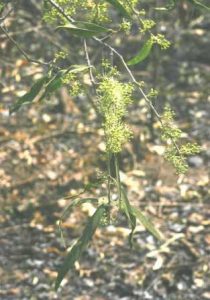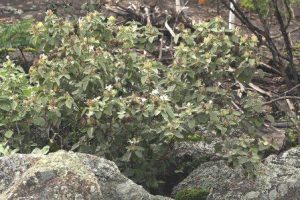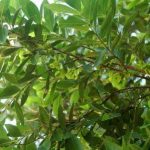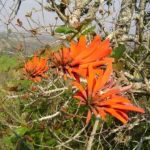TREE LIFE
OCTOBER 1980
As the Editor is on business somewhere on the shores of Lake Kariba (lucky girl), these notes are once again compiled by Hall. I have been asked for the source of my quotation last month under the heading ‘Ecological Collapse in History”. Apologies are offered for a possible breach in etiquette, the item quoted was from “Sennacherib’s Experiment : Cotton reaches the West” by B. Goosen – HISTORY TODAY of February 1952.
MASHONALAND CALENDAR
Tuesday October 7th : Botanic Garden Walk. Meet at the car park at 1700 hours.
Sunday October 19th : Bernard Mziki Shrine beyond Marandellas. Bus will leave Monomatapa Car Park at 0830 stopping at Beverley Rocks at 0845 hours. Fare will be $4.00. Book through Mrs. L. Irvine. Bring picnic lunch. Bring cups, tea and coffee will be available on arrival.
In terms of the constitution of our Society notice is hereby given that Subscriptions for 1981 will be :
Family membership $5.00
Single membership $4.00
Student membership $2.00
Subs have been kept for a number of years without increase, but projected costing of 1981 expenditure dictates this modest rise otherwise we would suffer a shortfall on income and expenditure.
BINGA SWAMP FOREST
Saturday 13th September in the morning a small party visited this patch of forest, regrettably without those two members who have done so much hard work to conserve the place and naturally I mean Mr. Stan Carey and Mr. Dick Petheram. Happily Mrs. Carey was able to be present and guide us around.
We were favourably impressed by progress in elimination of the exotic invader, Mauritius thorn and by good regeneration of desirable species. Binga has been well described by more able pen men than myself so I need create no word picture here. We spent a few pleasant hours wandering in the lovely forest conditions of this environmental gem, and to be statistical for a moment we pulled up about 50 thorn seedlings, one survivor alone reaching maturity would once again recreate the conditions of near destruction of the forest. So, we are currently winning but rather as the price of freedom is eternal vigilance, so is the price we will have to pay to keep Binga clear of thorn.
A few days later when attending the N.R.B. National Conference, I was very pleased to hear the Chairman, the Right Hon. Lance Smith pay a special tribute to the work done at Binga by Mr. Dick Petheram.
SEPTEMBER FIELD TRIP – SALISBURY

Boscia salicifolia. Photo: Bart Wursten. Source: Flora of Zimbabwe
On Sunday 21st September a small bus load descended on the charming homestead of Mr. Bobby Townsend – Munaka Park, south west of Mtoroshanga Village. The event was an important one because it represented our annual rendezvous with our Ayrshire Branch. Especially so as circumstances dictated that we did not meet last year. Better late than never and it was great to renew ties with Mrs. Graves and Mr. Le Clus, secretary and chairman of the branch, respectively, and with members of the branch. Our very grateful thanks to Mr. Townsend, both for his hospitality and the wonderful conservation work on his far, to Mr. Brian Tuke for leading us on a trail around the base of the gomo and to the ladies for dispensing tea.
Laid out on the lawn was Mrs. Benedicta Grave’s collection of woods, which we all found very illuminating and much discussion on timbers generally flourished around the tables on which the exhibits were displayed.
Next month we will put in print more detailed notes on the vegetation compiled by Anton Ellert. I must here however, comment on the floral jackpot we hit in coming over the Dyke on the day the local Ochna community came into flower. In groping for a way to describe this spectacle I can only liken it to “yellow” fire.
The tree in flower in the homestead garden was Boscia salicifolia, not looking at all as we see it nearer Salisbury.
MATABELELAND NOTES
October 5th : Game count by invitation of the Wild Life Society. Meet at Retreat Centre at 0700 hours. Bring pencil, binoculars, good walking shoes, and a small bottle of water. Bring lunch which may be eaten at the local club house.
Saturday 18th October : Meet at 1400 hours at the gates of Tshabalala Game Sanctuary.
Sunday November 2nd : Meet at Retreat Shopping Centre at 0830 hours for Toghwana Dam, Matopos. Bring a small water bottle and lunch.
Hillside Dam Walks : Remember these take place every 2nd and 4th Wednesday. See September Newsletter for details.
MATOPOS OBSERVATIONS

Barleria albostellata. Photo: BartWursten. Source: Flora of Zimbabwe
Many a time the plantations of Barleria albostellata, a shrub 2 metres high growing on the granite kopjes have made it extremely difficult to walk through. The white hairy leaves make you sneeze and the slender branches covered with lenticels hold you hack. In summer it might be conceded reluctantly that the white flowers are attractive, and recently a most interesting discovery was made of how the seeds are scattered. At the end of twigs are rounded bundles of dead leaves, bracts etc. with a few brown shiny “seeds” the size of pumpkin seeds, with a loose hairy sheath around them. They are really ovaries containing two seeds. They split vertically and two circular flattened seeds are thrown out with the aid of narrow sharp hooks. The seeds are covered with golden hairs, said to be hygroscopic.
These seed cases work up out of the grey crisp bundles in August; judging by the number of Barleria albostellata shrubs growing in the area it is a successful method of reproduction. It is well described in Trees of Southern Africa for other ACANTHACEAE. I think now that my reluctance to appreciate Barleria albostellata has gone.
COMBRETUM FOR BREAKFAST
In a note in the S.A. Journal “The Ostrich” Peter Steyn describes how he saw Parus niger holding down on to a branch winged fruit of Combretum molle with both feet and pecking at them. He refers to another description by C. Schoute-Vanneck in the Natal Bird Club News Sheet which supplies detailed information. He collected fruits from the ground and in 85% of those which had been pierced by the bird were silken threads and larva droppings, indicating that they had been infested by a parasite. He subsequently collected fruits from this tree and found they contained a fat white larva about 5mm long, later identified as the larva of Chalcid Wasps of the Family Eurytomidae.
Parus niger (Roberts 527) is a bird with a wide distribution, said to inhabit thick bush, mopane forest and even quite scrubby woodland where it hunts about from ground level to the tree tops in search of its food. Nests are built at the bottom of holes in hollow trees or tree stumps.
THE IMPORTANCE OF RECORDING OBSERVATIONS
OBJECTIVE of the Tree Society is to “collect and encourage collection of all forms of information relating to trees and to publish it by all available means”.
We are currently inviting members to so contribute their observations for publication, some I feel think that their contributions are of little interest and I would like to quote an extract from that famous naturalist/diarist Gilbert White of Selborne who recorded in 1788:
“One of my neighbours shot a ring dove on an evening as it was returning from feed and going to roost. When his wife had picked and drawn it she found the crop stuffed with the most nice and tender turnip tops. These she washed and boiled and so sat down to a choice and delicate plate of greens, culled and provided in this extraordinary manner. Hence we may see that granivourous birds when grain fails, can subsist on the leaves of vegetables”.
White’s contemporaries may well have been excused for saying he was wasting his time, and I dread to think what his ecclesiastical superiors opinion of his natural history writings must have been, but quite apart from the great pleasure his book has given to countless readers since then the above quotation with the facts it recorded was of great value to a scientific/agricultural study on the habits of pigeons two centuries later.
-G.H.
GEORGE HALL CHAIRMAN



